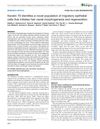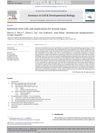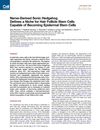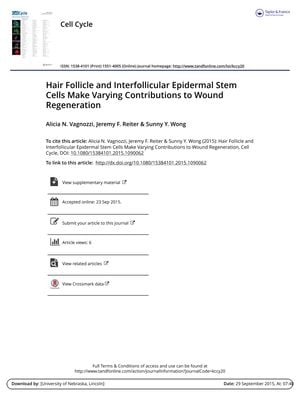TLDR Different skin stem cells help heal wounds, with hair follicle cells becoming more important over time.
The document summarizes a study that explored the roles of hair follicle (HF) and interfollicular epidermal (IFE) stem cells in wound regeneration. The study utilized genetic fate mapping in mice to track the contributions of different keratinocyte lineages over time. Initially, HF and IFE cells contributed almost equally to the regenerating basal epithelium, but by day 50, HF-derived cells became more dominant, making up 65-69% of the cells, with bulge-derived cells (a specific HF population) increasing to 19.5-26.4%. The study also found that suppressing Notch signaling allowed IFE-derived cells to out-compete HF-derived cells, indicating that Notch plays a role in cell differentiation and competitive dynamics during wound healing. The results suggest that the dynamics of cell contribution to wound healing are influenced by non-genetic factors and that both HF and IFE stem cells are important for the regeneration process, with HF-derived cells, particularly those from the bulge, becoming more significant in the long term.
479 citations
,
June 2014 in “Science” Epithelial stem cells can adapt and help in tissue repair and regeneration.
 60 citations
,
November 2013 in “Development”
60 citations
,
November 2013 in “Development” Keratin 79 marks a new group of cells that are key for creating and repairing the hair follicle's structure.
394 citations
,
October 2013 in “Nature”  156 citations
,
October 2012 in “Seminars in Cell & Developmental Biology”
156 citations
,
October 2012 in “Seminars in Cell & Developmental Biology” Different types of stem cells in hair follicles play unique roles in wound healing and hair growth, with some stem cells not originating from existing hair follicles but from non-hair follicle cells. WNT signaling and the Lhx2 factor are key in creating new hair follicles.
 396 citations
,
May 2011 in “Cell stem cell”
396 citations
,
May 2011 in “Cell stem cell” Nerve signals are crucial for hair follicle stem cells to become skin stem cells and help in wound healing.
253 citations
,
April 2008 in “Current opinion in cell biology” Notch signalling helps skin cells differentiate and prevents tumors.
170 citations
,
November 2007 in “The journal of investigative dermatology/Journal of investigative dermatology” Skin can heal wounds without hair follicle stem cells, but it takes a bit longer.
 829 citations
,
May 2007 in “Nature”
829 citations
,
May 2007 in “Nature” Hair follicles can regrow in wounded adult mouse skin using a process like embryo development.
1279 citations
,
November 2005 in “Nature Medicine” 1010 citations
,
August 2000 in “Cell” Hair follicle stem cells can form both hair follicles and skin.
1 citations
,
March 2022 in “IntechOpen eBooks” Aging reduces skin stem cell function, leading to changes like hair loss and slower wound healing.
 2 citations
,
May 2023 in “bioRxiv (Cold Spring Harbor Laboratory)”
2 citations
,
May 2023 in “bioRxiv (Cold Spring Harbor Laboratory)” Sebaceous glands can heal and regenerate after injury using their own stem cells and help from hair follicle cells.
 156 citations
,
October 2012 in “Seminars in Cell & Developmental Biology”
156 citations
,
October 2012 in “Seminars in Cell & Developmental Biology” Different types of stem cells in hair follicles play unique roles in wound healing and hair growth, with some stem cells not originating from existing hair follicles but from non-hair follicle cells. WNT signaling and the Lhx2 factor are key in creating new hair follicles.
 18 citations
,
December 2018 in “Expert Opinion on Biological Therapy”
18 citations
,
December 2018 in “Expert Opinion on Biological Therapy” Hair follicle stem cells are promising for wound healing but require more research for safe clinical use.

Ovol2 is crucial for hair growth and skin healing by controlling cell movement and growth.








